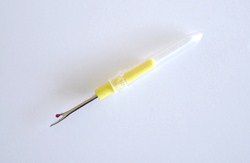|
Paper sticking tape
The ideal tape to glue all the pages for the mould on the hardboard. During the composing of the sail parts we also use this tape to fix the parts on the right spot.
Contact glue in a tube (preferred transparent)
You can use other glue, we recommend contact glue because it hardens completely. When using other glues, it's possible that the needle and thread get dirty and block your sewing work.
Sewing machine
We use mainly 3 different seams when sewing a kite:
the three-step zigzag seam: to sew the sail
the zigzag seam: to sew the lower part of the leading edge.
the straight seam: to sew the Velcro, the nose and the fortification of the Central-T
Fine en thick thread made of 100% polyester.
The fine thread is used for sewing the sail. For sewing the leading edges, the Velcro and the nose we better use a thick thread.
Needles “80” en “100”
Needle “80” is used with the fine thread. We try to keep the punctures in the sail as small as possible, to prevent tearing of the sail.
For the thick thread we use a needle “100”.
Big stopper needle without sharp point
To place the leechline
Small and strong thread/line
We need one that doesn't stretch too much, to use as a leech line.
Superglue
To glue the ferrule and other parts to the spars.
Lighter:
To singe the ends of bridle lines, this prevents wear out.
Option: Bridle ruler:
A wooden ruler (minimum 1 m - 3.5 feet) that has a nail close to one end. We can write down measures on the wood or glue a ruler on top. This tool is very handy when cutting a bridle and putting all the marks on the right spots
Pencil
Cutter
Measuretool
Metal rulers
Set square or triangle
|






